|
Introduction
This article proposes a number of hypothesis to explain the increase in
severe solar system weather and relates it to increased solar
activity. For example, from 1650 to about 1730 very few sunspots
occurred, see the graph below. This period corresponded to a
climatic period called the "Little Ice Age." Rivers froze that were
normally ice-free and snow fields remained year-round at lower
altitudes.

From a
New Scientist article of 02 Nov 2003, "There have been more
sunspots since the 1940s than for the past 1150 years (combined)."
That is a 1825% increase. Sunspots are the precursors of
solar
flares and coronal mass ejections and reflect the internal state of
the sun. Sunspot numbers were derived from levels of a radioactive
isotope found in ice cores taken from Greenland and Antarctica.
This article proposes that increased sun activity is related to
increases in cosmic dust which is being attracted by the Sun’s
magnetic field. In 2003, cosmic dust into our solar system increased
threefold. Between 2005 and 2013 cosmic dust will increase by
another factor of 3. If the Sun affects Earth weather, and increased
cosmic dust fuels the Sun, we are in for a rough ride. Of greatest
concern: volcano activity over the past 100 years has increased
500%. The timing of this increase is disturbing because the usually
dependable (every 600,000 years) Yellowstone super volcano is 40,000
years late.
Table of Contents
Ions Entering Our Solar System Cause Tremendous Changes

Differences Between the 1996 and 1999 Solar Maximums
Is Too Great (from Divine Cosmos)
In 1997, Russian scientist
DR. Alexey Dmitriev offered compelling
evidence that an increased number of ions were entering our solar
system. They were adding to the fuel to our sun and causing the
changes listed below. On 14 August 2003 an article appearing in
Space News confirmed Dmitriev’s theory by reporting that the
European Space Agency’s Ulysses spacecraft had detected that the
number of incoming particles to our solar system recently tripled
and the pace is expected to grow over the next decade (details in
this text far below).
The Sun went through a period of inactivity in the late 17th century
which corresponded to a climatic period called the "Little Ice Age."
Rivers froze that are normally ice-free al year and snow fields
remained year-round at lower altitudes. So it seems that solar
activity directly affects Earth weather. You can read more about the
affects on our weather produced by sun activity and the flow of
“nebular material” into the Solar System by reading an excerpt from
Paul LaViolette’s 1983 Ph.D. dissertation "Galactic Explosions,
Cosmic Dust Invasions, and Climatic Change."
From the Scientific Committee on Solar-Terrestrial Physics (SCOSTEP),
New Evidence of Space Weather Impact on the Terrestrial Weather and
Climate
Return
List of Changes to Our Solar System
These increases seem to be due to increased fuel to the sun. If that
is true, such events will continue to increase over the next few
years.
-
A 300% increase in the amount of "severe" solar activity than what
was formally predicted for the year 1997 alone (NASA 1998)
-
A 400% increase in the speed that solar particle emissions are
capable of traveling through the energy of interplanetary space
(NASA 1997-2001)
-
A 200% increase in tornadoes in unexpected areas such as Maryland
from 50 years ago.
Planetophysical State of the Earth and Life by
Dr. Dmitriev (1997)
-
A 400% increase in the overall number of natural catastrophes on
Earth between 1963 and 1993 (Dmitriev 1997)
-
A 230% increase in the strength of the Sun’s magnetic field since
1901 (Lockwood, 1998)
-
9 out of the 21 most severe earthquakes from 856-1999 AD occurred in
the 20th century (Russian National Earthquake Information Center,
1999)
-
A 400% increase in the number of earthquakes over 2.5 on the Richter
scale since 1973 (Manderville 1998)
-
A 500% increase in Earth’s volcanic activity between 1875 and 1993.
For increases between 1973 and 1998 see the graph below (Mandeville
2000 )
-
In a
New York Times article, Peter Becker, a scientist at the
Federal Standards Laboratory, an institution of 1,500 scientists
dedicated entirely to improving the ability to measure things
precisely admits that the kilogram standard comprised of
platinum-iridium is getting lighter.
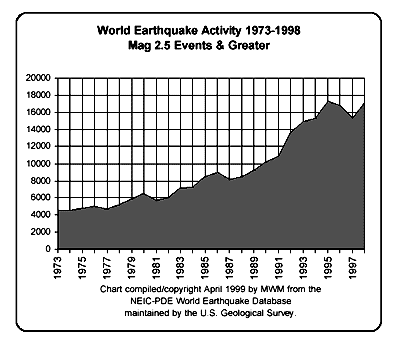
If we remember that the Sun contains fully 99.86% of the mass in the
Solar System, then we can easily see that it wields the strongest
thermal, gravitational and electromagnetic influence. Other possible
sun induced changes:
-
Recent magnetic pole shifts of Uranus and Neptune, as Voyager 2
observed their magnetic axes being significantly offset from their
rotational axes (Dmitriev 1997)
-
Visible brightness increases now being detected on Saturn (
Dmitriev
1997)
-
200% increase in the intensity of Jupiter’s magnetic field from
1992-97 (Dmitriev 1997)
-
200% increase in the known density of Mars’ atmosphere encountered
by the Mars Surveyor satellite in 1997 (NASA 1997)
-
Significant melting of Martian polar icecaps in just one year,
clearly seen in satellite photography (NASA 2001)
-
Significant physical, chemical and optical changes on Venus,
including a sharp decrease in sulfur-containing gases in its
atmosphere and increasing brightness ( Dmitriev 1997)
Return
Moon Craters Offer Evidence of 50 Time Greater Sunspot Activity in
our Past
Are we heading for a tremendous increase in sunspots and resultant
serve, life threatening Earth catastrophes? From Paul LaViolette’s
1983 Ph.D. dissertation
Galactic Explosions, Cosmic Dust Invasions,
and Climatic Change:
One of the most amazing discoveries of the
Apollo 11 manned landing
on the Moon was that small lunar craters frequently contain lumps of
soil whose upper surfaces are coated with a glassy glaze. The glassy
patches that were photographed at close range by Apollo astronauts,
Gold, T.:
"Apollo II Observations of a Remarkable Glazing Phenomenon
on the Lunar Surface."
Science 165 (1969).
These provide a record of
past solar flare activity. Assuming that the cratering rate has
remained relatively constant for the past 2 X 10^4 years, Zook,
Hartung, and Storzer (1977) conclude that solar flare activity must
have been about 50 fold higher about 16,000 years ago.
Return
David Wilcock Has Compiled Excellent Theories
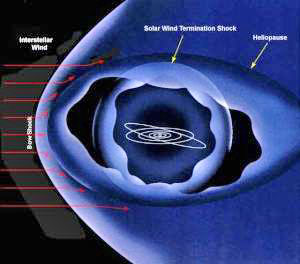 David Wilcock seems to have found the most intriguing theories on
cosmology and what is happening to our solar system. David Wilcock seems to have found the most intriguing theories on
cosmology and what is happening to our solar system.
Regarding
cosmology, Wilcock drawers on the experiments of
Dr. N.A. Kozyrev
which prove the existence of aether. His theory on the current
status of our solar system comes primarily from a paper, "Planetophysical
State of the Earth and Life" published in 1997 by Russian scientist
DR. Alexey Dmitriev.
Dmitriev offers compelling evidence that matter and energy
containing ions of hydrogen and helium and hydroxyl are entering our
solar system in increasing numbers that are having powerful effects
on all our planets. You can read more about the effects on our
weather produced by sun activity and the flow of “nebular material”
into the Solar System by reading an excerpt from Paul LaViolette’s
1983 Ph.D. dissertation "Galactic Explosions, Cosmic Dust Invasions,
and Climatic Change."
Return
More Dust Arrived in 2003 and More is Coming
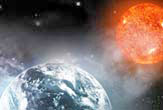 On 14 August 2003 an article entitled, "Defenses Down, Galactic Dust
Storm Hits Solar System," appeared in Space News discussed the data
being collected by the Ulysses spacecraft. The article made the
following announcement: On 14 August 2003 an article entitled, "Defenses Down, Galactic Dust
Storm Hits Solar System," appeared in Space News discussed the data
being collected by the Ulysses spacecraft. The article made the
following announcement:
The number of incoming particles recently tripled and the pace is
expected to grow over the next decade.
The article went on to say that the rate is expected to stay
constant until 2005, and then increase by another factor of 3 prior
to 2013. The solar magnetic field, which often protects us from
charged particles, is at its current 22 year cycle low. Each year,
the magnetic field will get stronger and push more dust away.
Some
day however, the influx could get worse. The solar system is plowing
toward a galactic cloud known as the G-cloud.
"The time of the entry
into the G-cloud is unknown, but is expected to occur any time in
the next 10,000 years... There will be a constant increase in dust
rates, because the G-cloud is more dense than the local interstellar
cloud that is now surrounding our Sun."

To verify the accuracy of the above article, I (Paul
Winter) contacted Research
Professor Jeffrey Linsky of the
University of Colorado at Boulder. He developed a model for the
Local Interstellar medium and has predicted our entry into the
G-cloud to occur within 3000 years. He pointed out that the
Ulysses
data was only 10 years old,
"Extrapolating from only 10 years of
data is very risky. One hundred years of data are probably needed to
remove the solar magnetic cycle effects to determine a secular
trend."
Since the solar magnetic field plays a large role in
repulsing dust particles and the field strength has an 11 year
cycle, the predictions made about future dust particle quantity
based on the Ulysses data must be looked at as a very rough
estimate. Professor Linsky went on to comment about the predicted
higher density of the G-cloud as compared to the
LIC (Local
Interstellar Cloud) which we are now in,
"I know of no evidence for
this. My best guess is that the densities are about the same." He
made additional comments about the two clouds, "However, nobody
knows whether the two clouds are in direct contact, whether there is
very hot gas between the clouds, or whether there is a cooler and
denser interface between the two clouds."
To read more on a layman’s view of
Dmitriev’s Planetophysical State
of the Earth and Life, read
Chapter 8 of the Divine Cosmos by
David Wilcock. The Divine Cosmos is the source for much of the information
on this "The Sun Is Freaking Out" article. You can also read
Dmitriev’s
report simply translated from Russian into English, but it is a bit
difficult to follow.
Return
Wilcock Relates Sun Activity to Earth Catastrophes
Although conventional science is willing to admit that CMEs (coronal
mass ejections), usually following large solar flares) create
geomagnetic disturbances, they do not correlate such activity to
severe earth whether or earthquakes.
David Wilcock does.
From
Chapter Eight of Wilcock’s "The Divine Cosmos":
On April 2, 2001, solar flare number 9393 broke all records for
brightness and strength, weighing in at the unheard-of X-class of
22; the measurement scale had previously only been designed to go to
a frightful maximum of 20. This flare was considered the largest of
its kind ever observed for at least 25 years, earning it the new
name of “mega-flare.” It was nearly three times more powerful than
the March 1989 event, which totally shut down Canada’s power grid.
Fortunately, the X-22 level of radiation from flare number 9393 did
not directly impact the earth.
On April 10, 2001, two
CMEs were released. Then, on April 11th, a
rash of severe tornadoes, some a quarter of a mile wide, ripped
through the Midwestern United States, affecting Kansas, Iowa,
Oklahoma, Missouri and Nebraska. Furthermore, a 5.7 earthquake
occurred in Indonesia on April 7, a 5.9 earthquake on April 13 that
destroyed 30,000 homes in China, and a 6.5 on April 15 off the coast
of Japan. Most scientists would not be willing to acknowledge the
connection between the solar activity and events such as severe
weather and earthquakes, but again we see how the energy phenomena
are related. All these events clustered around the surge in solar
activity of April 10th.
 For 2003 From CNN For 2003 From CNN
In an article entitled "Sun Erupts in Biggest Storm in Years"
by
Kate Tobin on October 28, 2003, details of the third largest solar
flare (x18) were reported. Although CNN and does not maintain its
articles for very long, you may be able to read the details
here.
From Space Weather News
An X-class solar flare erupted near sunspot 486 at 0650 UT on Oct.
26th. Another X-class flare erupted near sunspot 484 less than
twelve hours later at 1815 UT. At least one of these eruptions, and
possibly both, has hurled a coronal mass ejection (CME) toward
Earth.
Right: SOHO’s
extreme UV telescope photographed this prominence
rising above the sun’s southwestern limb on Oct. 26th at 0119 UT.
The giant loop is as tall as 30 planet Earths. Astronomers can’t
remember the last time this happened: two Jupiter-sized sunspots
crossing the face of the sun at the same time. Sunspots 484 and 486
have tangled magnetic fields that pose a threat for powerful X-class
solar flares--like the one this morning.
Return
|
The Weather in 2003 Verifies Wilcock’s Theories
If Wilcock is correct, the weather and sun related catastrophes in
2003 should be very high and drop-off in 2004.
It seems that this
article pretty much sums up the weather for 2003, "135 Tornadoes Hit
US Since Sunday" 5-8-3 (CNN),
"Forecasters are warning that
conditions are ripe for Kansas, Missouri and Arkansas to be hit by
more tornadoes Thursday.... Kansas, Missouri and Arkansas were
heavily damaged earlier this week in one of the most intense
outbreaks of tornadoes in 53 years of record-keeping.
More than 40
people have been killed in the non-stop storms. In Chattanooga,
Tennessee, authorities there were battling to keep the Tennessee
River from rising any further. The river has already reached its
highest levels in 30 years."
The heat wave that hit Europe in the summer of 2003 killed an
unprecedented number of people. France alone lost
10,000 people to
the heat wave.
Return |
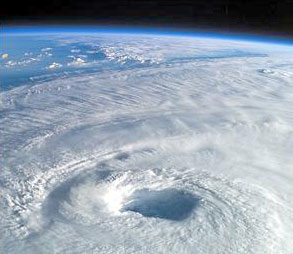
Hurricane Isabel from Space 2003. Isabel recorded wind speeds over
300 MPH (second highest ever recorded) |
|
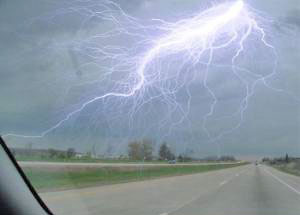
Intense Electrical Storm 2003 |
The Volcanoes in 2003 Verify Wilcock Theories
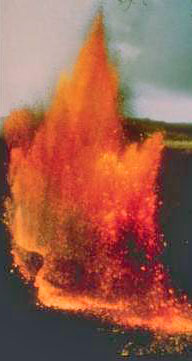 Wilcock showed that increased sun activity increases volcanic
activity on Earth by correlating coronal mass ejections. If Wilcock
is right about the weather changes, we should see increased volcanic
activity in the year 2003. That is exactly what happened. Based on
volcano data from the
University of North Dakota updated July 28,
2003, so far, at seven months into 2003, there have been 82
eruptions. There were 31 eruptions in all 12 months of 2002 and that
is after a roughly 500-percent increase in worldwide volcano
activity since 1975. There are two large, overdue volcanoes that may
be triggered by this increased activity, the Yellowstone super
volcano which could cover half the United States in ash and the
volcano on La Palma in the Canary Islands which could set off a
tidal wave to devastate the east coast of the United States. Wilcock showed that increased sun activity increases volcanic
activity on Earth by correlating coronal mass ejections. If Wilcock
is right about the weather changes, we should see increased volcanic
activity in the year 2003. That is exactly what happened. Based on
volcano data from the
University of North Dakota updated July 28,
2003, so far, at seven months into 2003, there have been 82
eruptions. There were 31 eruptions in all 12 months of 2002 and that
is after a roughly 500-percent increase in worldwide volcano
activity since 1975. There are two large, overdue volcanoes that may
be triggered by this increased activity, the Yellowstone super
volcano which could cover half the United States in ash and the
volcano on La Palma in the Canary Islands which could set off a
tidal wave to devastate the east coast of the United States.
Update
In March 2004, 300 elk were paralyzed and died in Wyoming near
Yellowstone National Park. Scientists have ruled out disease as a
cause of death to the elk which are known to be bright eyed and
healthy. Some people are saying that the official lichens as a cause
of death to the 300 elk is misinformation.
Some of the gases that are released from a volcano are deadly to
animals and humans. And, in fact, one of these gases, hydrogen
fluoride causes paralysis then death. If it was hydrogen fluoride,
it is highly indicative that the area has become highly unstable.
Return
Yellowstone’s Super Volcano
|
Hopefully, the increased volcano activity over the past few years
will not set off Yellowstone’s super volcano. Unfortunately, it
erupts with near-clockwork precision every 600,000 years. The last
eruption was more than 640,000 years ago - we are overdue for
annihilation.
Super volcanoes do not form mountains. They actually create
depressions in the ground called calderas. In super volcanoes the
magma is so viscous that volcanic gasses that normally trigger an
eruption cannot pass, so a massive amount of pressure begins to
build up. This continues for hundreds of thousands of years until an
eruption occurs, which blasts away a huge amount of ground, forming
a new caldera.
Scientists searching for the caldera in Yellowstone park could not
see it because it was so huge - only when satellite images were
taken did the scale of the caldera become apparent, 53 miles by 28
miles (click the map to the
right.) |
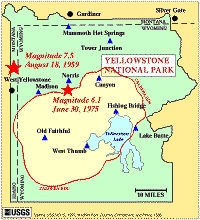
Yellowstone Caldera, 53 Miles by 28 Miles |
The super volcano watch web site:
The Toba caldera in Sumatra, Indonesia, is another large
super-volcano. Around 74,000 years ago, Toba erupted
catastrophically, releasing an estimated 1,735 cubic miles of
sulfur-charged magma (mostly as ash) to great heights. This eruption
reduced world temperatures 5° to 10° C for several years (from The
Hutton Commentaries on
pole shifts).
Return
A 100 Year World Wide Increase In Volcanic Activity

Not only has there been a dramatic increase in volcanic activity for
2003, but volcanic activity has been increasing for over 100 years.
The graph to the left was developed by Michael Mandevill who has
written an
analysis of the relationship between the 6
½ year
wobble of the earth (due to the pull of the sun and the moon) and
volcanic activity.
Yellowstone - Continuing Bad News - 9-8-03
Here is a 9/8/03
report from Dr. Bruce Cornet
Geologist, Paleobotanist, and Palynologist:
I have been not wanting to post about the recent quake increase at
Yellowstone until I was sure. Starting last Thursday, I noticed an
increase in several things on the seismos around Yellowstone:
-
Previously ’quiet’ mountains are starting to show small EQs
(Earthquakes)
-
’Flatline’ vibrations are increasing
-
Glacier Peak is showing an increase in local EQs
-
Several seismos are
’in sync’ with each other regarding readings
(usually indicates a deep quake effecting several mountains)
-
Nearby states are showing an increase in EQs
-
The quakes are starting to be
’long and drawn out’ instead of your
typical 3-5 min shakers
-
Usually quiet seismos are showing
’micro spikes’

Mt. Sheriden is a Tiny Cap Sitting on a Huge Keg
....Ground temperatures in the northwestern part of the park are up
to 200º F in some places.
What to Watch Out for:
If more steam vents appear, the pressure in the magma chamber will
continue to drop until it reaches a critical stage when the
superheated water within the magma explodes. When that happens the
super-volcano will blow violently in a Pompeii-like explosion, but
100,000 times worse.
# End of selected excerpts from Cornet’s report.
From Armageddon Online’s
super volcano web page:
Immediately before the eruption of
Mt. Sheriden, there would be
large earthquakes in the Yellowstone region. The ground would swell
further with most of Yellowstone being uplifted. One earthquake
would finally break the layer of rock that holds the magma in - and
all the pressure the Earth can build up in 640,000 years would
explode a huge chunk out of the Yellowstone caldera.
 Magma would be flung 30 miles into the atmosphere. Within 600 miles
virtually all life would be killed by falling ash, lava flows and
the sheer explosive force of the eruption. Volcanic ash would coat
places as far away as Iowa and the Gulf of Mexico. One thousand
cubic kilometers of lava would pour out of the volcano, enough to
coat the whole of the USA with a layer 5 inches thick. The explosion
would have a force 2,500 times that of Mount St. Helens
(click image right). It would be
the loudest noise heard by man for 75,000 years, the time of the
last super volcano eruption. Within minutes of the eruption tens of
thousands would be dead. Magma would be flung 30 miles into the atmosphere. Within 600 miles
virtually all life would be killed by falling ash, lava flows and
the sheer explosive force of the eruption. Volcanic ash would coat
places as far away as Iowa and the Gulf of Mexico. One thousand
cubic kilometers of lava would pour out of the volcano, enough to
coat the whole of the USA with a layer 5 inches thick. The explosion
would have a force 2,500 times that of Mount St. Helens
(click image right). It would be
the loudest noise heard by man for 75,000 years, the time of the
last super volcano eruption. Within minutes of the eruption tens of
thousands would be dead.
The long-term effects would be even more devastating. The
thousands
of cubic kilometers of ash that would shoot into the atmosphere
could block out light from the sun, making global temperatures
plummet. This is called a nuclear winter. As during the Sumatra
eruption a large percentage of the world’s plant life would be
killed by the ash and drop in temperature. Also, virtually the
entire of the grain harvest of the Great Plains would disappear in
hours, as it would be coated in ash. Similar effects around the
world would cause massive food shortages. If the temperatures
plummet by the 21 degrees they did after the Sumatra eruption the
Yellowstone super volcano eruption could truly be an extinction
level event.
If we make it through 2003, we should be OK until 2005 when
the sun will start to act up again and cause more earthquake and volcanic
activity on our planet.
Here is a comprehensive graph that compares the number of
earthquakes around Yellowstone to the lifting of the ground. From
Predicting Yellowstone by Robert B. Trombley, Ph.D., Southwest
Volcano Research Center, Apache Junction, Arizona USA.
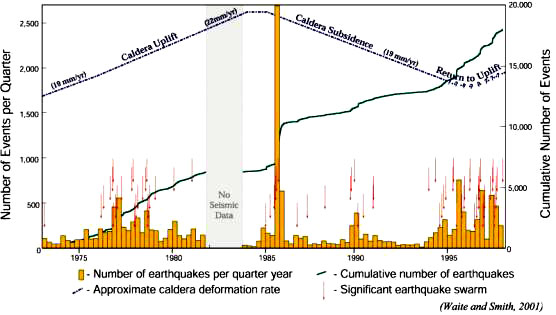
An excellent
Yellowstone super volcano web site.
Notice how the wavy line of
cumulative earthquakes starts to get steeper after 1995.
Volcano Links from the Doomsday Guide web site. The best collection
of volcano links on the Web including a link to a web site about
predicting Yellowstone.
Return
Astronauts Notice Noctilucent Clouds
From
Science@NASA "Strange Clouds" article.
In February
2003, space station astronauts noticed the increased
observability of noctilucent clouds high in our
atmosphere. The clouds are about 50 miles above the
Earth. They were first seen in 1885 two years after the
eruption of the Krakatoa volcano which sent ash as high
as 40 miles high into Earth’s atmosphere.
Eventually
the ash settled, but the noctilucent clouds remained
viewable if you traveled to latitudes above 50 degrees.
However, in recent years noctilucent clouds can be seen
as far south as Utah and Colorado.
I believe this is an indication that volcanic activity around the
globe and mostly in the ocean, has increased to such an extent that
the ash released is increasing the visibility of noctilucent clouds.
That is a lot of ash which can only be explained by the large
increase in volcanic activity for 2003. This increase is exactly
what was predicted and is right on time.
Return |
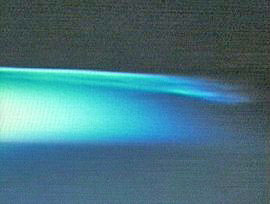 |
|
 |
From the Canary Islands Comes a Wave to End the East Coast
 La Palma is the largest of the western Canary Islands and rears
21,320 ft (6500 m) above the surrounding ocean floor. La Palma is
not only the steepest island in the world but has also been the most
volcanically active of the Canary Isles in the past 500 years. There
have been two eruptions on the island this century alone - the last
one was in 1971.
More details from the source. La Palma is the largest of the western Canary Islands and rears
21,320 ft (6500 m) above the surrounding ocean floor. La Palma is
not only the steepest island in the world but has also been the most
volcanically active of the Canary Isles in the past 500 years. There
have been two eruptions on the island this century alone - the last
one was in 1971.
More details from the source.
The following warning was issued in 2001:
300 ft. waves traveling at
500 MPH will devastate the eastern seaboard of America and inundate
much of southern Britain, say scientists who have analyzed the
effects of a future volcanic eruption in the Canary Islands. A
massive slab of rock (left of the heavy gray lines) would break away
from the island of La Palma and drop into the Atlantic Ocean to
cause a tsunami - a monster wave - bigger than any recorded, the
scientists warned yesterday. Details from
http://www.cdnn.info/article/tsunami/tsunami.html
If earthquakes and volcanic activity continued to increase at the
current rates, how can this landslide not occur?
What You Can Do
If the Yellowstone super volcano erupts and dust falls in your area
in a significant amount, you may not be able to go outside
unprotected for days.
You should:
-
Keep extra food and water on hand.
-
Buy a case of dust masks, about $20 for a case of 20.
-
Monitor this the
Volcano News web page.
If you live on the East Coast of the U. S., and the
La Palma
landslide occurs, learn how to surf really big waves.
Return
Other Effects of This Increase in Volcanic Activity
Robert Felix says that the increase in volcanic activity is warming
the oceans. This is increasing precipitation and bringing more snow
to northern areas some of which is not melting in the summer. He
also states that
global warming is a myth and that the next ice age
could begin any day.
Andrew Kenny agrees: and if the global warming scare has little
foundation in fact, the ice-age scare is only too solidly founded.
For the past two million years, but not before, the northern
hemisphere has gone through a regular cycle of ice ages: 90,000
years with ice; 10,000 years without. The last ice age ended 10,000
years ago. Out time is up. The next ice age is due. -
The Ice Age
Cometh.
Return
Ultimate Secret of The Mayan Calendar
For more information on the effect of the sun changes on the Earth,
read a summary of the work of Dr. S.V. Smelyakov in
The Ultimate
Secret of The Mayan Calendar. This summary includes information on
global natural cataclysms on Earth and phenomena in space, such as
supernovas of nearby stars.
Return
Another View on the End of a 26,000 Year Cycle of the Mayan Calendar
Carlos Barrios a historian, anthropologist and investigator, studied
with traditional Mayan elders for 25 years. And has became a Mayan Ajq’ij, a ceremonial priest and spiritual guide. He has an
alternative view about the significance of 2012 (this article starts
with information regarding the effect of the war in Guatemala on the
Mayan people, then gets into the Mayan calendar). This article was
written by
Steven McFadden. Carlos Barrios feels that,
"We are at the
cusp of the era when peace begins, and people live in harmony with
Mother Earth. We are no longer in the World of the
Fourth Sun, but
we are not yet in the World of the Fifth Sun. This is the time
in-between, the time of transition."
Return
|






 On 14 August 2003 an article entitled, "
On 14 August 2003 an article entitled, "
 For 2003 From CNN
For 2003 From CNN










 La Palma is the largest of the western Canary Islands and rears
21,320 ft (6500 m) above the surrounding ocean floor. La Palma is
not only the steepest island in the world but has also been the most
volcanically active of the Canary Isles in the past 500 years. There
have been two eruptions on the island this century alone - the last
one was in 1971.
La Palma is the largest of the western Canary Islands and rears
21,320 ft (6500 m) above the surrounding ocean floor. La Palma is
not only the steepest island in the world but has also been the most
volcanically active of the Canary Isles in the past 500 years. There
have been two eruptions on the island this century alone - the last
one was in 1971.